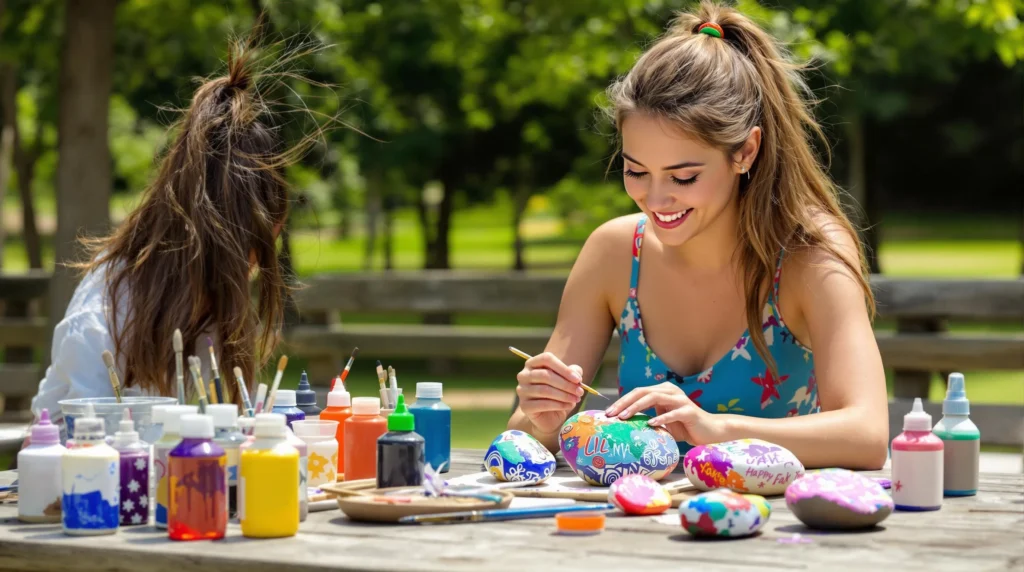Looking to transform ordinary rocks into extraordinary works of art? We’ve spent countless hours testing dozens of acrylic paints to bring you the absolute best options for rock painting. Whether you’re a seasoned rock artist or just starting your creative journey, choosing the right paint makes all the difference.
The perfect acrylic paint for rocks needs to be durable, weather-resistant, and vibrant enough to make your creations stand out. We know how frustrating it can be to spend time on a rock masterpiece only to have the colors fade or chip away after exposure to the elements. That’s why we’ve narrowed down the top performers that will ensure your artistic vision stays beautiful for years to come.
Why Acrylic Paint Is Perfect for Rock Painting Projects
Acrylic paint stands out as the ideal medium for rock painting due to its exceptional versatility and durability in outdoor conditions. Unlike other paint types, acrylics adhere firmly to non-porous stone surfaces without requiring extensive preparation. They create a water-resistant barrier once dry, protecting your artwork from rain, sun, and seasonal changes that would quickly deteriorate other paints.
The quick-drying nature of acrylics makes your rock painting projects efficient, allowing you to apply multiple layers or colors within a single session. Artists particularly appreciate how acrylic paints can be thinned with water for wash techniques or used straight from the tube for bold, opaque coverage depending on the desired effect.
Various finishes from matte to glossy provide creative flexibility, letting you customize the final appearance of your painted rocks. The color retention capabilities of quality acrylics ensure your designs stay vibrant for years, even when placed in gardens or landscapes with direct sunlight exposure.
We’ve found that acrylic paints work wonderfully on virtually any rock type, from smooth river stones to rough volcanic specimens. Their ability to be sealed with varnish or clear acrylic spray offers additional protection for pieces meant to withstand outdoor elements, making them truly the superior choice for rock painting enthusiasts at any skill level.
10 Best Acrylic Paints for Rock Painting in 2023

After extensive testing and research, we’ve compiled a definitive list of the top acrylic paints that deliver exceptional results for rock painting projects.
Arteza Outdoor Acrylic Paint Set
Arteza Outdoor Acrylic Paint stands out for its exceptional vibrancy and weather resistance. These paints maintain their brilliant color intensity even after extended outdoor exposure, making them perfect for rock painting projects meant to withstand the elements. Their smooth consistency allows for easy application while providing excellent coverage with minimal coats needed.
Apple Barrel Acrylic Create Paint
Apple Barrel offers an impressive range of colors at a budget-friendly price point without compromising quality. Their formula provides good coverage on rock surfaces and dries to a durable finish that resists fading when sealed properly. We appreciate how these versatile paints work well for both beginners and experienced rock painters looking for affordable options with reliable performance.
Crafts 4 ALL Acrylic Paint Set
Crafts 4 ALL delivers exceptional value with their comprehensive color selection at an accessible price point. These paints feature a medium consistency that works well on rock surfaces without requiring excessive thinning. Their quick-drying formula enables efficient layering techniques, while the finished result maintains good color vibrancy when protected with an appropriate sealer.
FolkArt Outdoor Acrylic Paint
FolkArt Outdoor Acrylic Paint earns our recommendation specifically for rock painting due to its ideal thickness and extensive color variety. The paint’s consistency strikes the perfect balance – thick enough to provide solid coverage yet fluid enough for detail work without thinning. These paints adhere exceptionally well to rock surfaces and maintain their vibrant appearance even when exposed to outdoor conditions.
Liquitex Professional Acrylic Paint
Liquitex Professional stands as a favorite among serious artists for its outstanding quality and performance characteristics. The rich pigmentation delivers intense, true colors that maintain their vibrancy over time. These premium paints offer excellent coverage and flow smoothly onto rock surfaces, allowing for precise detail work and sophisticated techniques that elevate rock painting projects to true artistic expressions.
Golden Heavy Body Acrylics
Golden Heavy Body Acrylics represent the professional standard with their exceptional pigmentation and color depth. These high-quality paints maintain remarkable color integrity and provide unmatched coverage on rock surfaces. While their thicker consistency may require some thinning for detailed rock painting, the extra effort pays off with stunning results that showcase superior light-fastness and durability compared to standard acrylics.
DecoArt Americana Outdoor Living Paint
DecoArt Americana Outdoor Living Paint specializes in creating durable finishes that withstand environmental challenges. Their formula adheres exceptionally well to rock surfaces and resists fading, chipping, and weather damage without requiring additional sealants. The paint’s moderate viscosity allows for smooth application while delivering excellent opacity that brings rock painting designs to life with lasting vibrancy.
Magicfly Acrylic Paint Set
Magicfly Acrylic Paint Set provides rock painters with a versatile selection of colors that perform impressively on stone surfaces. The smooth consistency flows effortlessly onto rocks while maintaining strong pigmentation that doesn’t fade easily when properly sealed. These paints dry relatively quickly, enabling efficient layering and blending techniques that help create depth and dimension in rock painting projects.
Posca Paint Markers
Posca Paint Markers revolutionize detailed rock painting with their precise application capability. These acrylic paint pens excel at creating intricate designs, fine lines, and small details that would be challenging with traditional brushes. Their water-based formula adheres exceptionally well to rock surfaces and dries to a permanent, opaque finish that resists fading when exposed to light, making them invaluable tools for adding finishing touches to rock painting projects.
Martha Stewart Multi-Surface Acrylic Paint
Martha Stewart Multi-Surface Acrylic Paint offers impressive adaptability across various materials, including rocks. The formula provides excellent adhesion to stone surfaces without requiring extensive preparation. These paints deliver a smooth, even application with a satin finish that enhances the natural beauty of painted rocks. Their color palette features sophisticated tones that coordinate beautifully, allowing for cohesive and elegant rock painting designs.
Key Features to Look for in Acrylic Paints for Rocks

When selecting acrylic paints for your rock painting projects, certain features can make a important difference in the quality and longevity of your artwork.
Weather Resistance
Weather resistance ranks as a critical feature for rock art that will live outdoors. Standard acrylic paints typically require sealing with varnish or an outdoor sealant to withstand environmental elements. Multi-surface satin acrylics and outdoor create acrylics offer superior protection against water and weather without additional sealing. These specially formulated options save you time and provide peace of mind that your creations will maintain their beauty even though exposure to sun, rain, and seasonal changes.
Opacity and Coverage
Coverage quality directly impacts the vibrancy and professional look of your rock art. Create acrylics often require 2-4 coats for full coverage due to their thinner consistency. Thicker formulations like Liquitex Basics, Folk Art, and ARTEZA deliver better opacity and color vibrancy with fewer applications. Chalky or multi-surface acrylics generally improve coverage on light-colored rocks but may streak when applied to darker stones. We recommend testing your paint on a similar-colored rock before starting your masterpiece to ensure satisfactory coverage.
Drying Time
Acrylics dry remarkably quickly, allowing artists to apply second coats within minutes rather than hours. Fast-drying formulas such as create and chalky acrylics perfectly suit projects requiring rapid layering techniques. This quick-setting attribute enables you to complete complex designs in a single session without waiting extended periods between layers. Artists can efficiently build dimension and depth without frustrating delays, making acrylics ideal for both beginners and experienced rock painters with limited time.
Finish Types
Finish options vary widely among acrylic paints, creating different aesthetic effects for your rock art. Standard create and chalky acrylics leave a flat, matte finish that works beautifully for natural-looking designs or vintage styles. Multi-surface and outdoor create acrylics produce shiny or satin finishes that enhance color vibrancy and provide additional protection. Artists can customize their preferred sheen by mixing different media, such as matte or gloss mediums, with their paints to achieve the perfect finish. Selecting the appropriate finish complements your design concept and contributes significantly to the overall impact of your painted rocks.
How to Prepare Rocks for Acrylic Painting
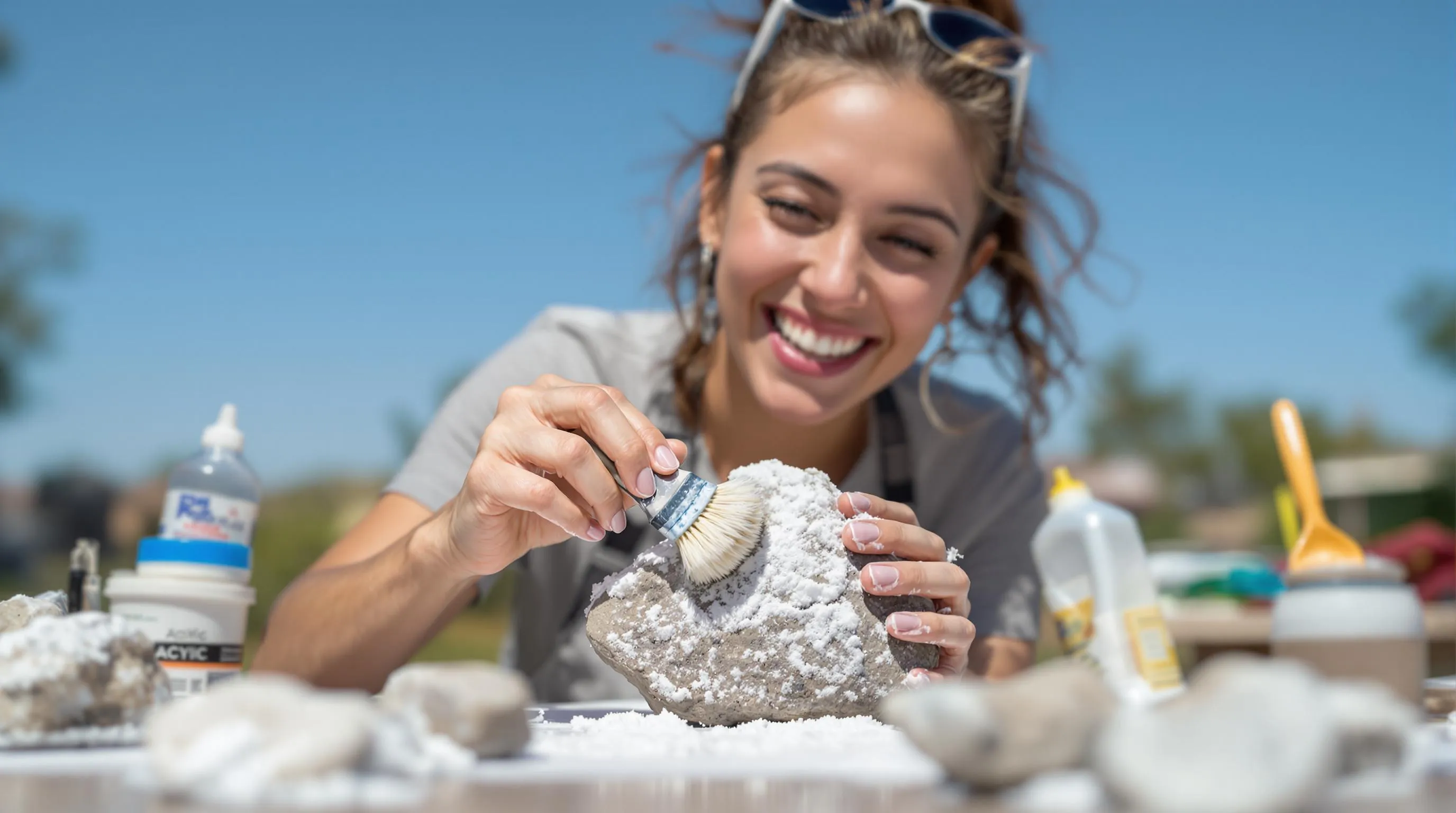
Properly preparing your rocks before painting is crucial for creating long-lasting rock art. We’ve found that taking the time to prep your canvas ensures better paint adhesion and more vibrant results. Follow these essential steps to get your rocks ready for your next acrylic masterpiece:
1. Clean the Rocks Thoroughly
Start by washing your rocks with water and mild soap to remove all dirt, debris, and natural oils. Any residue left on the surface can prevent paint from adhering properly. Rinse the rocks completely to ensure no soap remains, as soap residue can affect paint application.
2. Remove Surface Impurities
Use a soft brush to gently scrub away any stubborn imperfections or particles that remain after washing. This step helps create a smooth surface for your artwork and prevents unwanted texture in your final piece. Pay special attention to crevices and rough areas that might trap dirt.
3. Allow Rocks to Dry Completely
Place your cleaned rocks in a warm, dry area and allow them to dry thoroughly before painting. Attempting to paint on damp rocks will result in poor adhesion and potential flaking of your design later. Depending on the porosity and size of your rocks, drying could take several hours or even overnight.
4. Apply a Base Coat or Primer (Optional)
For rocks with highly porous surfaces, applying a coat of gesso or acrylic primer creates an even base for your artwork. This optional step particularly helps when working with darker rocks or when you want vibrant colors to pop. Products like Liquitex Basics Gesso provide an excellent foundation for your acrylic paints.
5. Seal Your Finished Artwork
After completing your painting and allowing it to dry fully, protect your creation with a clear varnish. We recommend using Krylon UV-Resistant Clear Acrylic Coating or DecoArt DuraClear Gloss Varnish to shield your artwork from sunlight, moisture, and other environmental factors. The sealing process significantly extends the life of your rock art, especially for pieces displayed outdoors.
By following these preparation steps, you’ll create the perfect canvas for your acrylic paints to shine. The time invested in proper preparation pays off with more professional-looking results and rock art that withstands the test of time.
Essential Techniques for Painting Rocks with Acrylics
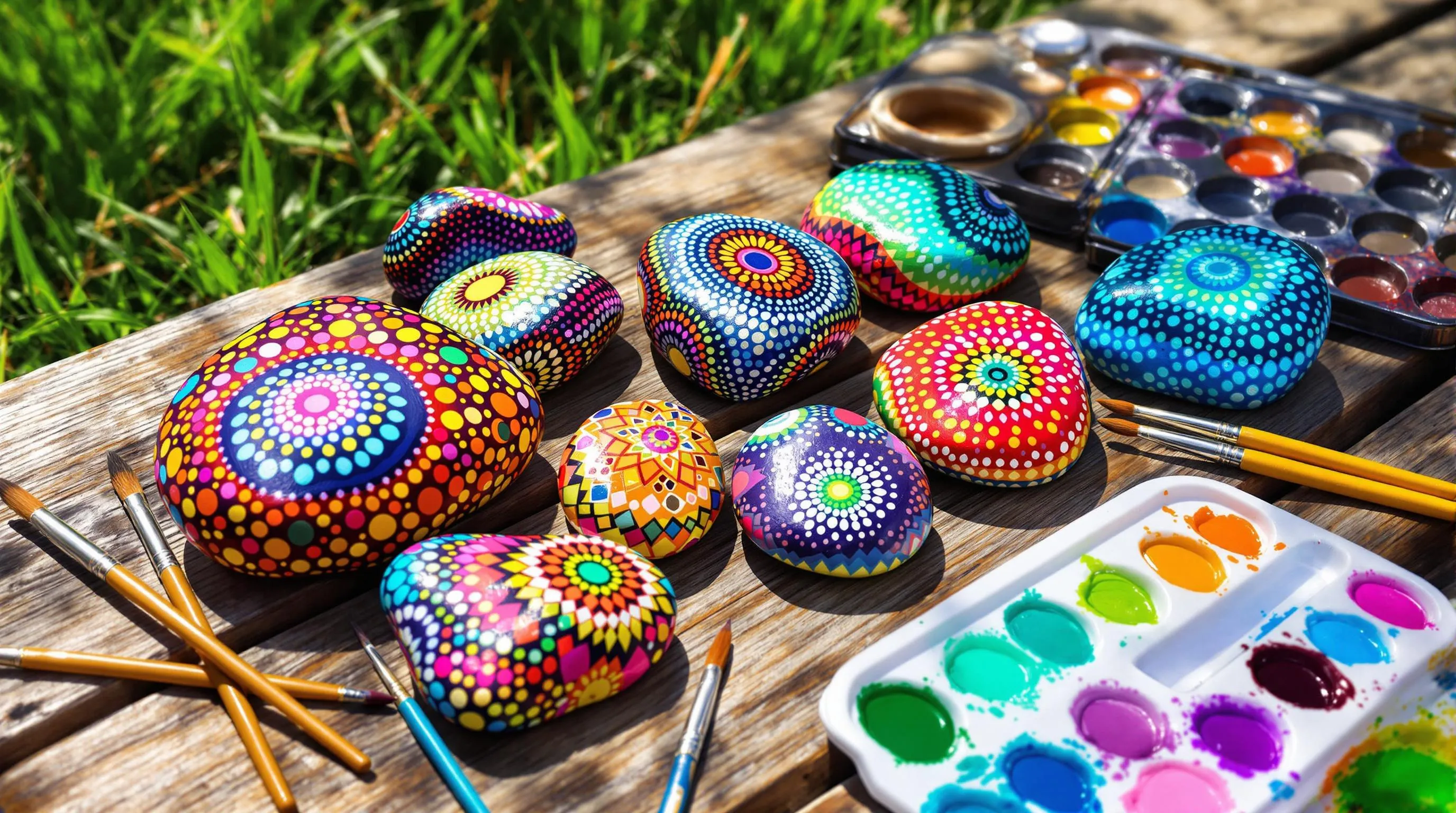
Surface Preparation
Surface prep is crucial for creating lasting rock art. Before applying any paint, thoroughly clean your rocks using warm water and mild soap to remove dirt, oils, and debris. Let the rocks dry completely, as moisture can prevent paint from adhering properly. Applying a white acrylic base coat or gesso creates an ideal canvas for your artwork, improving color vibrancy and improving paint adhesion on porous surfaces.
Effective Layering
Layering techniques help achieve depth and dimension in your rock designs. Start with thin layers of fluid acrylics rather than thick applications to avoid cracking as the paint dries. Building up color gradually allows for more control and precision, especially when creating intricate patterns or mandalas. Allow each layer to dry completely before adding the next to prevent colors from blending unintentionally.
Dotting Methods
Dotting creates eye-catching patterns and textures on painted rocks. Use a stylus tool, the back of a paintbrush, or specialized dotting tools with diluted paint for best results. Creating uniform dots requires consistent pressure and properly thinned paint consistency. Practice different dot sizes and spacing on scrap paper before applying the technique to your rocks for more controlled results.
Sealing Finished Artwork
Protecting your rock art from environmental damage ensures its longevity. Apply a UV-resistant varnish like Krylon Kamar or DecoArt DuraClear after your paint has completely dried (typically 24 hours). Multiple thin coats of sealant offer better protection than a single thick layer. Outdoor rocks benefit from 2-3 coats of waterproof sealant to shield against rain, sun exposure, and general weathering.
Essential Tools
The right tools significantly impact your rock painting results. Synthetic brushes in various sizes work best with acrylics – round brushes for details and liner brushes for fine lines. Plastic palettes or ceramic plates provide ideal surfaces for mixing colors. Keep water handy for thinning paints and cleaning brushes between colors. A heat tool or hairdryer can speed up drying times between layers for more efficient painting sessions.
Paint Selection Tips
Fluid create acrylics offer versatility for most rock painting projects. Their thinner consistency enables smooth application and precise detailing on textured rock surfaces. For complex designs requiring intense color saturation, professional-grade paints with higher pigment loads perform exceptionally well. Heavy-body acrylics should be diluted with water or acrylic medium before application to prevent uneven coverage and texture issues on rock surfaces.
Best Sealants to Protect Your Acrylic-Painted Rocks
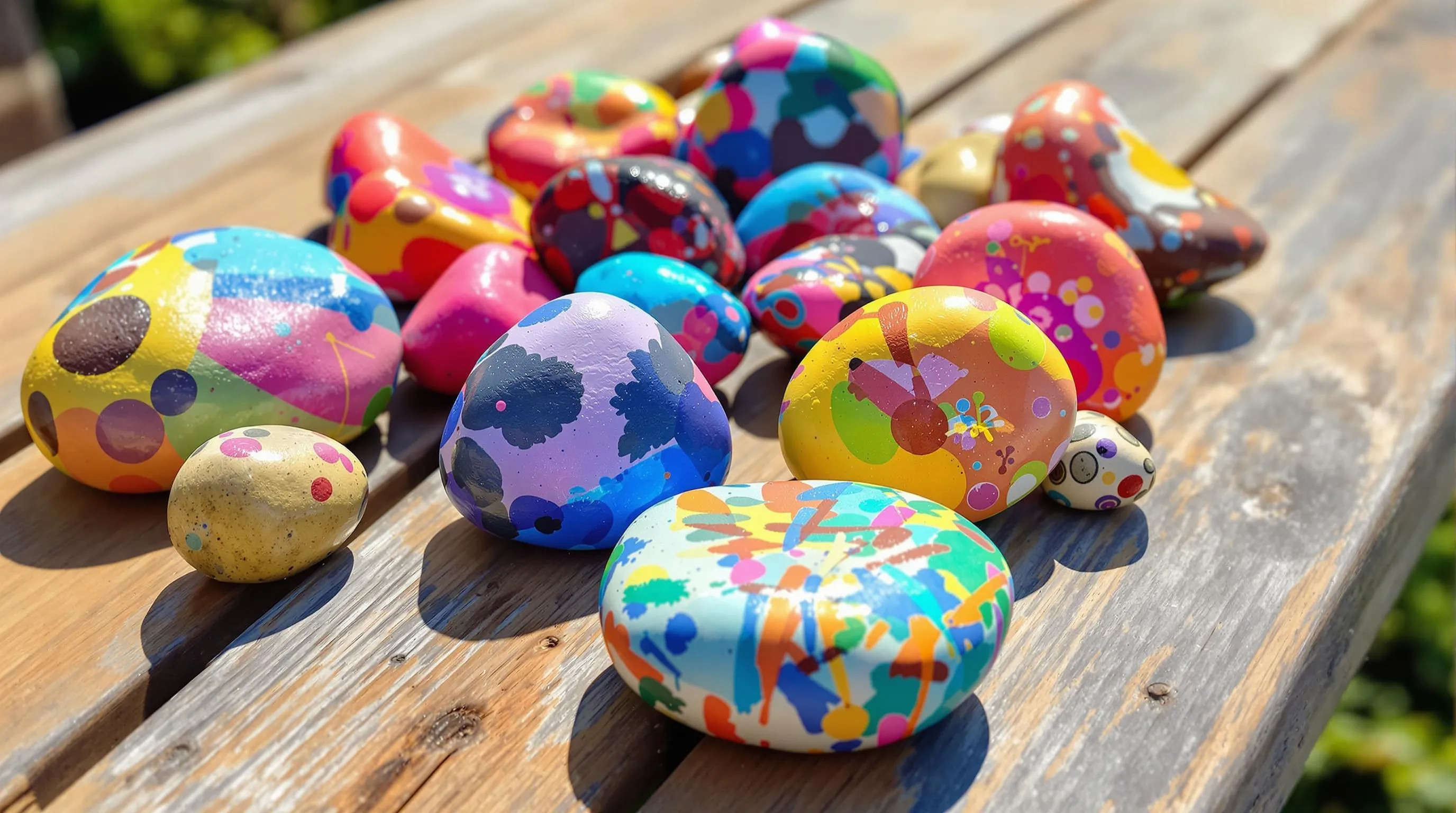
After creating your rock masterpiece, protecting it from the elements is crucial for longevity. We’ve tested many sealants to determine which ones truly preserve your artwork against rain, sun, and time. Here are the top options for keeping your painted rocks looking vibrant for years:
Spray Sealants for Maximum Protection
Spray sealants offer quick, even coverage that creates a protective barrier without disturbing your designs:
- Krylon Kamar Varnish provides an excellent gloss finish that enhances color vibrancy while creating a durable protective layer. This product works exceptionally well when you want to maintain the brilliant colors of your rock artwork.
- Krylon UV-Resistant Clear Acrylic Coating stands out for its superior UV protection capabilities, making it ideal for rocks displayed in sunny outdoor locations. Your creations will resist fading and color deterioration, even with constant sun exposure.
- Rust-Oleum Clear Topcoat delivers outstanding waterproofing properties that shield your painted rocks from rain and moisture damage. This sealant creates a robust barrier that prevents water from seeping into the paint layers.
Brush-On Sealants for Detailed Control
For those who prefer more precise application or have intricate designs, brush-on options offer greater control:
- DecoArt DuraClear Gloss Varnish features anti-yellowing properties that maintain the true colors of your artwork over time. This varnish ensures your designs retain their original appearance without developing that undesirable yellow tint.
- Mod Podge Matte delivers a sophisticated non-glossy finish perfect for indoor or covered outdoor projects. The subtle matte effect creates a professional look while still providing adequate protection for rocks not directly exposed to harsh weather.
Choosing the Right Sealant for Your Project
Several factors should influence your sealant selection:
- UV Exposure Considerations: Projects placed in direct sunlight require specialized protection—prioritize Krylon UV-Resistant or Rust-Oleum sealants for maximum defense against fading and deterioration.
- Finish Preferences: Gloss finishes enhance color vibrancy and create a wet-look effect, while matte options reduce glare and provide a more subtle, sophisticated appearance.
- Application Environment: Indoor rock art typically needs less intensive protection than outdoor pieces that face rain, temperature changes, and direct sunlight.
By selecting the appropriate sealant for your exact project needs, you’ll ensure your acrylic rock paintings remain vibrant and intact for years to come. Remember that properly sealed rocks can become lasting keepsakes or outdoor decorations that withstand the test of time.
Common Mistakes to Avoid When Painting Rocks
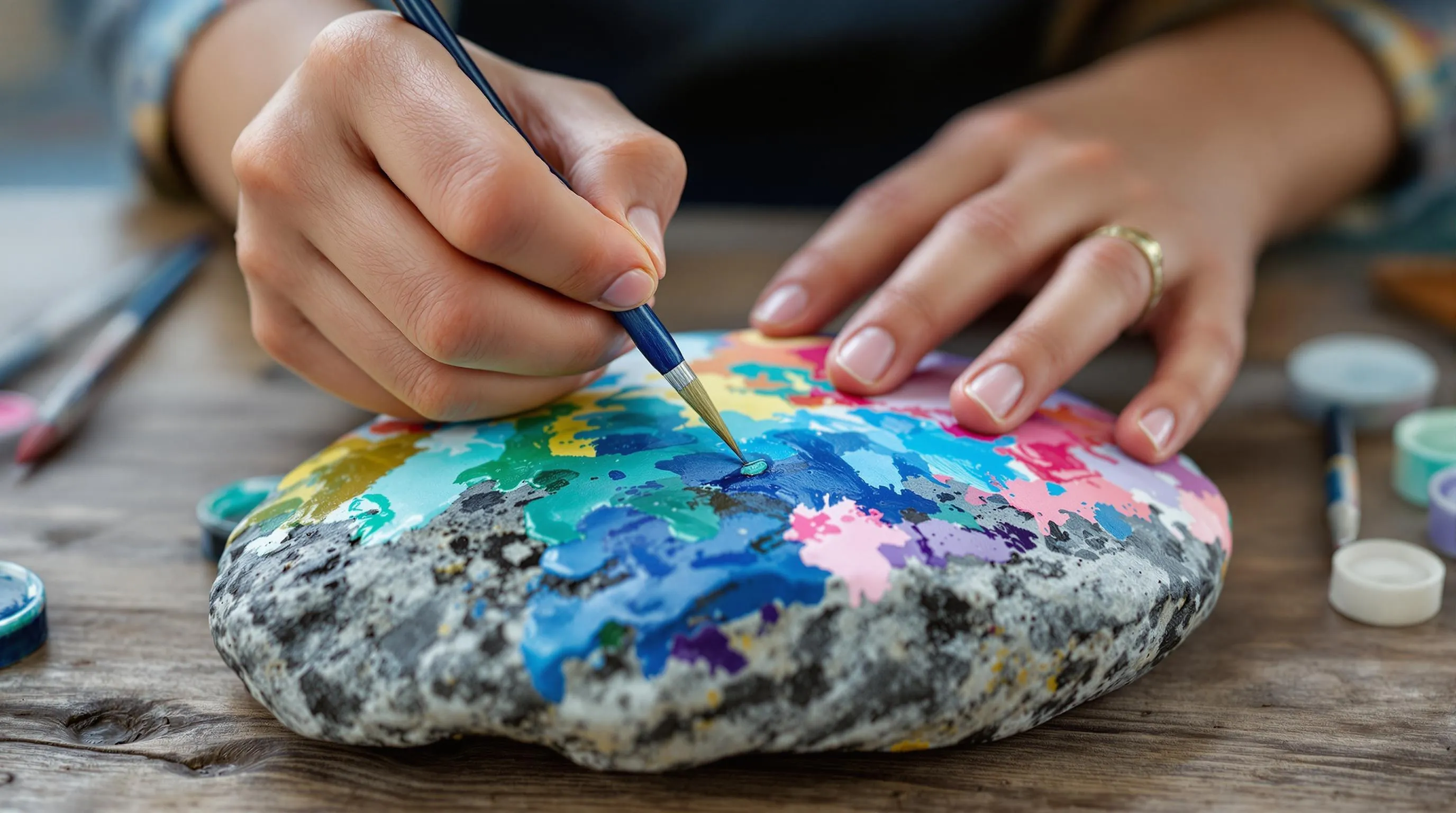
Using Thick Paints Without Thinning
Thick acrylic paints often create uneven strokes when applied directly to rock surfaces. We’ve found that thinning your paint with a small amount of water or an acrylic medium significantly improves consistency and workability. This simple adjustment allows for smoother application and better control of your design. Artists who skip this step frequently end up with chunky, textured finishes that may crack over time.
Not Sealing the Paint
Failing to apply a protective clear coat is perhaps the most common mistake we see among rock painting enthusiasts. Without proper sealing, your beautiful artwork remains vulnerable to weathering, fading, and chipping. For optimal protection, use quality sealants like Krylon Kamar varnish or DecoArt DuraClear, which create a durable barrier against moisture and UV damage. Your unsealed rock art might look perfect initially but can deteriorate rapidly when exposed to outdoor elements.
Not Cleaning the Rock Surface
Dirt and oils on rock surfaces significantly impact paint adhesion, leading to peeling and flaking artwork. We recommend thoroughly washing rocks with mild soap and water before painting to remove any surface contaminants. This crucial preparation step ensures your Folk Art or Liquitex acrylics can properly bond with the rock surface. Clean rocks provide the ideal canvas for creating long-lasting painted designs that won’t prematurely deteriorate.
Applying Too Many Coats Too Quickly
Rushing the painting process by layering colors before previous coats dry completely results in smudging and uneven texture. Each layer of Mont Marte or ARTEZA acrylic paint needs adequate drying time to set properly. Patience during this process prevents colors from mixing unintentionally and maintains the crisp lines of your design. Allowing proper drying time between applications creates professional-looking rock art with distinct color separation and sharper details.
Conclusion: Choosing the Right Acrylic Paint for Your Rock Art
Armed with the right acrylic paints and techniques we’ve shared you’re now ready to transform ordinary rocks into extraordinary art. Remember that quality matters when selecting your paints – opt for weather-resistant formulations with good opacity for the best results.
The preparation process is just as crucial as your paint selection. Clean thoroughly apply thin layers and always seal your finished work to ensure it withstands the elements for years to come.
Whether you’re a beginner or experienced artist the perfect acrylic paint for your rock painting journey is on our list. We’re confident that with these recommendations and tips you’ll create vibrant long-lasting rock art that showcases your creativity and brings joy to all who discover it.
Frequently Asked Questions
What makes acrylic paint ideal for rock painting?
Acrylic paint is perfect for rock painting because it adheres well to non-porous stone surfaces, creates a water-resistant barrier when dry, and dries quickly for efficient layering. It’s versatile enough to be thinned or used straight from the tube, offers various finishes (matte to glossy), and provides excellent color retention. These qualities ensure vibrant designs that last, even in outdoor conditions, making acrylics superior for rock artists of all skill levels.
Which acrylic paint brand is best for weather-resistant rock art?
Arteza Outdoor Acrylic Paint Set stands out for weather-resistant rock art, offering exceptional vibrancy and durability in outdoor conditions. For premium quality, Liquitex Professional Acrylic Paint and Golden Heavy Body Acrylics provide superior weather resistance. DecoArt Americana Outdoor Living Paint is specifically formulated for durability in changing weather conditions, making it another excellent choice for outdoor rock art projects.
Do I need to seal my painted rocks?
Yes, sealing painted rocks is highly recommended, even when using weather-resistant acrylics. A quality sealant creates an additional protective barrier against UV rays, moisture, and physical damage. Products like Krylon Kamar Varnish (spray) or DecoArt DuraClear (brush-on) will significantly extend your artwork’s lifespan. Without sealing, even the best acrylic paints may eventually fade or chip when exposed to outdoor elements.
How should I prepare rocks before painting?
Clean rocks thoroughly with mild soap and water to remove dirt and oils that prevent adhesion. Use a scrub brush for stubborn residue, rinse completely, and allow to dry completely (ideally 24 hours). For highly porous rocks, apply a base coat or primer to enhance color vibrancy. Smooth rocks might benefit from light sanding to create texture for better paint adhesion. Proper preparation ensures professional-looking results.
What’s the best technique for creating detailed designs on rocks?
For detailed rock designs, use thin layers of fluid acrylics and allow proper drying between applications. Dotting tools (bamboo skewers, toothpicks, or specialized dotting tools) create precise patterns. Small synthetic brushes (sizes 0-2) are ideal for fine lines. Paint markers like Posca provide excellent precision for intricate details. Work from background to foreground and practice on scrap paper before applying to your rock.
How long should acrylic paint dry between coats?
Allow 15-30 minutes between thin acrylic paint layers on rocks. Thicker applications may require 1-2 hours before applying additional coats. Complete drying takes 24-72 hours depending on humidity, temperature, and paint thickness. Rushing between coats can cause smudging, color mixing, or cracking. Use a fan to gently accelerate drying time, but avoid direct heat sources which may cause paint to crack.
What are the most common mistakes when painting rocks?
Common rock painting mistakes include: applying paint too thickly (causes cracking), skipping proper cleaning (reduces adhesion), not sealing finished artwork (leads to weathering), and rushing between coats (creates smudging). Also problematic is using low-quality paints that fade quickly, painting rocks that aren’t completely dry, and overworking wet paint. Taking time with each step yields better, longer-lasting results.
Can I use regular craft acrylics for outdoor rock displays?
While regular craft acrylics will work for rock painting, they may fade quickly when placed outdoors. For outdoor displays, choose paints specifically labeled “outdoor” or “weather-resistant” like Arteza Outdoor, FolkArt Outdoor, or DecoArt Americana Outdoor Living. Regular craft acrylics can be used for outdoor rocks only when properly sealed with a UV-resistant, waterproof sealer applied in multiple coats.

